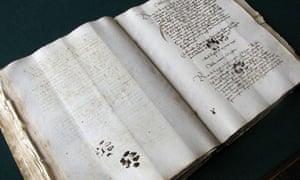Evidence of feline interference in a 15th-century manuscript reminds us of how big an impression they've made on literature as a whole

Paw presentation ... marks on 1445 ‘Lettere e commissioni di Levante’. Photograph: Emir Filipović
Alison Flood
Friday 5 April 201311.33 BST
Emir Filipović, an academic at the University of Sarajevo, was researching his PhD in the Dubrovnik State Archives when he stumbled across a medieval Italian manuscript from 11 March 1445, from "the 13th volume of a series of archival registers called 'Lettere e commissioni di Levante'".
Doesn't sound that exciting, does it? But the discovery has placed Filipović at the centre of a social media whirl – because the medieval manuscript was stained with inky cat paw prints. I dropped Filipović a line, and he says he's still surprised at how popular the photograph has proved to be ("Cats - walking all over your shit since the 15th century", says a Reddit post).
"I think that one of the main reasons why people seemed to have a positive response to it is down to the fact that it makes you imagine the scene in your head when the cat jumped onto the book. This especially appeals to cat owners, who are, I suppose, familiar with such typical cases, but also to people who do not own pets since they can still identify with the unfortunate scribe," Filipović says.
"One other important thing is that some people seem to equate the past times with history as a (boring) school subject focused primarily on politics and wars. They forget that the past was full of 'normal' everyday events, just like today, and a picture such as the one with the cat pawprints tends to remind everybody that people who lived in the past were not much different than ourselves."
I think that's spot-on – those of us with cats know exactly how annoying/endearing it is to have a purring feline trying to climb onto our keyboards while we're working, and I just love the thought of a medieval scribe being equally irritated. If not more – at least we can just delete.
Could it also be down to the fact that cats and literature, as Filipović puts it in a blogpost about his discovery, make a good combination? I'm now trying to think of my favourite literary cats, and I'm swamped with choice. Obviously there's the Cheshire Cat, but thinking of children's literature makes me remember how much I adored Barbara Sleigh's Carbonel books, and Paul Gallico's Jennie, as a child – and as a parent how much I am now enjoying Lynley Dodd's Slinky Malinkibooks. ("Slinky Malinki was blacker than black, a stalking and lurking adventurous cat.")
Dodd comes up with some great names for her feline creations – Butterball Brown, Pimpernel Pugh, Greywacke Jones – but obviously, no one beats TS Eliot when it comes to the Naming of Cats. Mr Mistoffelees, old Deuteronomy, Rum Tum Tugger, Skimbleshanks – and my personal favourite,Macavity. I'll leave you with a few lines to whet your appetite.
Macavity's a Mystery Cat: he's called the Hidden Paw -http://www.theguardian.com/books/booksblog/2013/apr/05/cats-mark-centuries-books-15th-century
For he's the master criminal who can defy the Law.
He's the bafflement of Scotland Yard, the Flying Squad's despair:
For when they reach the scene of crime – Macavity's not there!
Macavity, Macavity, there's no one like Macavity,
He's broken every human law, he breaks the law of gravity.
No comments:
Post a Comment